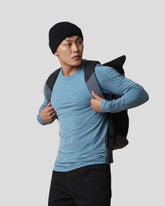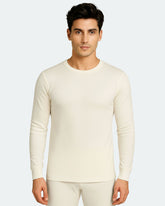Waterproof vs Water-Resistant Jackets: Which One Do You Really Need?
In times of cold season or when the rainy days are in full bluster, your outerwear is the only form of defense against these elements. However, choosing the right one can be conflicting and lead to indecisiveness as it requires understanding.
So, when shopping for the right jacket you must have already encountered the confusing duo of water-resistant and waterproof. But what do these terminologies mean, and when and where should they be used?
Water-resistant and waterproof are often interchangeable words. But mind you, they are not synonyms. One does not define the other.
We are here to help you understand these terms so the next time around, when gearing up for a hike through misty trails or braving the winter snow you will be well prepared come whatever.
This blog will help you understand the subtle yet important distinction between these two words.

Model in Kosha’s waterproof jackets for winter, styled for snow and travel comfort.
Real Scenario: Packing for the Unpredictable
Let's say you are getting ready for a trek in Himachal or an elusive winter trip to Switzerland. You have packed your base layers and mid-layers, but what about your outer? Usually, people freeze here.
Do you go with a simple lightweight shell or a heavier, insulated option? Well, the answer lies in the climate where you are going and your activity level. Let’s break it down together.

Real-world adventure in the Himalayas highlighting the choice between waterproof jackets vs water-resistant jackets for alpine conditions.
What Does Waterproof Mean?
Imagine walking out of a storm completely dry. Sounds impossible right? But I kid you not. Not with Waterproof jackets for winter which are made of materials that are impervious to water and have strong corrosion resistance regardless of the duration you have been exposed to water.
Features of Waterproof Jackets
-
Made of materials that are impervious to water
-
High corrosion resistance
-
Outer fabrics with fully taped seams
-
Built-in membrane linings laminated in layers
-
Keeps skin dry by pushing moisture away for evaporation
Pro tip: Hydrostatic head is the method by which a fabric's waterproofing qualities are tested against increasing water pressure. Remember the higher rating of a jacket = better waterproofing.
What Does Water Resistance Mean?
Water-resistant jackets, as their title implies, resist water from wicking through.
They do well against mild rainfall and light splashes by repelling water but fail to provide complete proofing against it.
How Water-Resistant Jackets Work
-
Handle mild rainfall and light splashes
-
Lack fully taped seams
-
Eventually give in to heavy moisture over time
The very best water-resistant outerwear has a repellent method layered on it. This method is called durable water repellency (DWR).
Waterproof vs Water-Resistant Jackets: DWR's Role and Which One Is Better?
Have you ever noticed how raindrops seem to just roll off the surface of the jacket as if there was a force field surrounding it? This is not a work of magic but rather a coating device called DWR (durable water repellent).
It is the method by which chemicals are used to coat the outer layer of the jacket, giving it water-repellent properties instead of absorbing it.
DWR is an important coating treatment that most top brands incorporate in both Waterproof jackets and Water-resistant Jackets.
 Kosha’s DWR-treated outerwear doubles as rainproof winter jackets for light snow and drizzle.
Kosha’s DWR-treated outerwear doubles as rainproof winter jackets for light snow and drizzle.
DWR in Action
In Water-Resistant Jackets:
-
Great for light rain or snow
-
Works temporarily
-
Wears off after prolonged exposure
In Waterproof Jackets:
-
Works with an inner membrane (like Gore-Tex or Kosha’s fabrics)
-
Even if DWR wears off, inner layers keep water out
-
Taped zippers + sealed seams make them nearly impenetrable
Want all-weather protection? Explore our collection of Winter Jackets For Men.
Breathability & Layering
Breathability, in simple terms, is determined by the way a fabric regulates heat and sweat. Performing your everyday activities or otherwise can cause your body to generate heat and moisture.
Breathability means how well your jacket lets heat and sweat escape. If they have no space to leave, you will end up feeling dank as if you had just walked out of a sauna.
How they stack up:
Water-Resistant Jackets:
-
Lightweight and membrane-free
-
Allow airflow to circulate
-
Ideal for activities with movement (like short hikes or commutes)
-
Can be easily worn over hoodies or fleeces
-
Let you stay warm but not sweaty
Waterproof Jackets:
-
Multi-layered and thicker
-
Trap heat easily
-
Require more strategic layering
-
Offer better insulation in extreme cold
Quick Tip: Match Layering to Temperature
You can pack waterproof jackets with Kosha's merino wool base layer and mid-layer fleece for between 15°C to -20°C temperatures, and always be mindful of other factors like wind, humidity, and your activity.

This Kosha jacket brings clarity to the debate of waterproof jackets vs water-resistant jackets, showcasing a smart balance of protection and packability.
The Key Takeaway: What should you go for?
Choose water-resistant jackets if:
-
You prefer breathable, lightweight fabric
-
You need to layer easily for everyday wear
Choose waterproof jackets for winter if:
-
You’re exposed to heavy rain or snow
-
You need full protection, even at the cost of breathability
Conclusion
The best rainproof winter jackets amalgamate waterproofing and insulation. Needless to say, they are your all-in-one answer to rain, snow and sleet. You won't even have to switch jackets constantly in the face of unpredictable weather.
At Kosha, we believe you should thrive in Winter without compromising on style and warmth. Whether you're off to the mountains or taking a walk in the city streets you can bet on us to keep warm, dry and cosy.

Braving the snowy slopes in Kosha gear: a true test for reliable jackets for snow and rain.
Need to make the right Pick? Let us Help.
Very often, when we travel to a winter destination, we are unsure how to stay warm. Especially if you’ve never experienced snow before. Not sure which jacket to pack?
Chat on WhatsApp with our Kosha layering expert and let’s get you ready for your adventure!
FAQs
Q1: Can I use these jackets in both snow and rain?
Yes. Good jackets for snow and rain offer dual performance when equipped with sealed seams and proper insulation. Kosha offers many such options that are stylish yet technical.
Q2: I sweat a lot while walking in cold cities. What should I buy?
A water-resistant outerwear option with breathable mesh lining may be more suitable than full waterproof jackets, especially for urban movement.
Q3: Are Kosha jackets sustainable and animal-friendly?
Absolutely. Kosha avoids leather and down. All waterproof jackets for winter are made with eco-conscious, cruelty-free materials.





